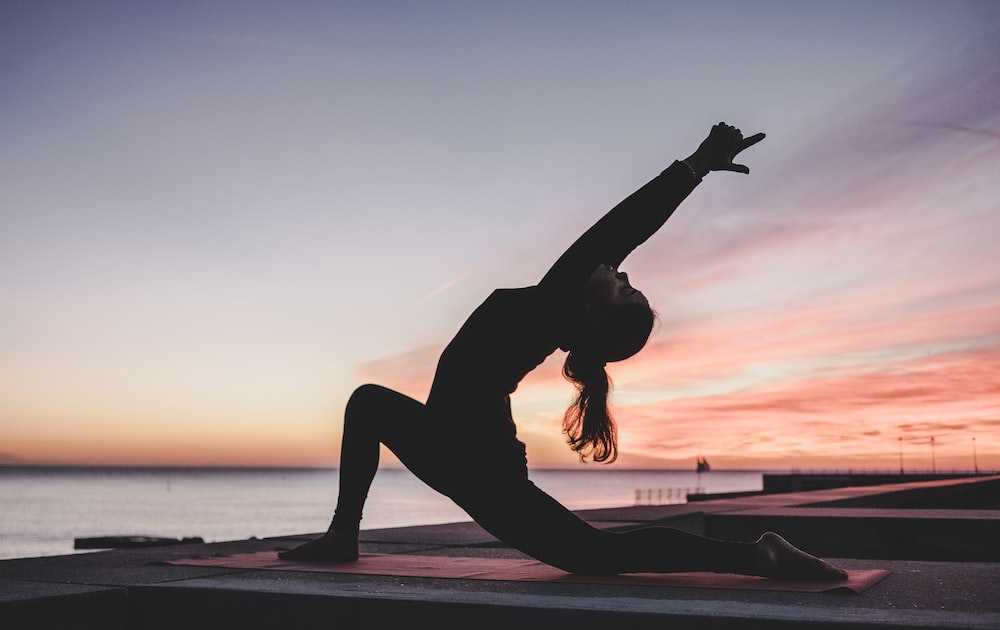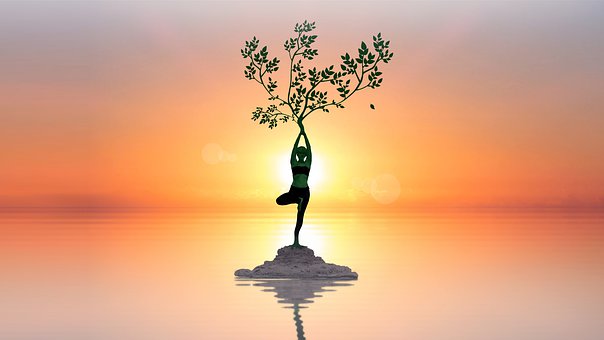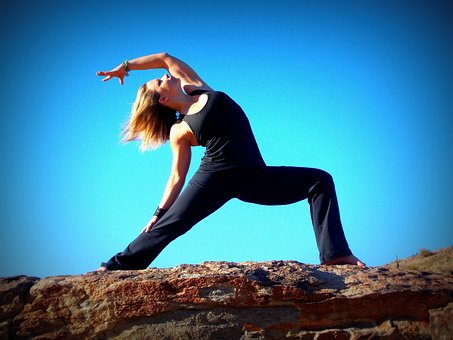To begin with, let’s delve into the world of yoga.
Yoga- “Yog” word is derived from Sanskrit word “Yuj”, meaning “to unite”.
According to ancient science, yog means deep connection between body, mind and soul.
5000 years ago, in “Rig Veda” about yoga was described.
we all know that, Shree Maharshi Patanjali is the founder of yoga.
Yoga is a practice that involves physical posture, breath control and meditation.
Moreover, it is holistic discipline that originated in ancient india.
Additionally, yoga has gained popularity worldwide in recent years due to its lots of benefits.
Furthermore, yoga can be practiced by people of all ages and fitness levels.
In fact, it is versatile activity that can be modified to suit individual needs and abilities.
Furthermore, the practice of yoga promote flexibility, strength and balance.
Moreover, it enhances mental focus and reduce stress levels.
Additionally, yoga can be powerful tool for cultivating mindfulness and inner peace.
Finally, incorporating yoga into your daily routine can have positive impact on your overall well-being.
Today, Yog is converted into Yoga and in some places, Yoga is known as Pilates. Difference between Yoga and Pilates is both Yoga and Pilates are slow forms of exercise.
In Yoga, You hold a particular position termed asana.
In Pilates-Continuous movement of position and then challenge on your core muscles, that is termed core strengthening exercise.
Benefits of Yoga; –https://sparklinglifestyle.in/the-relationship-between-sleep-weight-loss/

- Moreover, yoga offers numerous benefits for the body, mind and soul.
– Help you internally as well as externally to heal the body.
-Additionally, Improve body strength, balance, stamina and flexibility.
– Improve body posture.
– Relief in back pain.
– Helping boost Your metabolism and digestive system.
– Yoga stimulates the nervous system that can relax you and help you sleep better.
– Increase blood circulation.
– Besides, yoga helps to regulate blood sugar level.
– Boost muscle strength.
– In addition, yoga maintain spinal cord health.
– Boosts fertility and helps to recover PCOD and PCOS.
– Activate the reproductive system.
– Furthermore, Stimulate excretory urinary system- some yoga posture massages your internal body organ and increase blood circulation so that their functions will improve.
– When you hold your breath in some asanas, improve functions of the respiratory system that can improve lungs and heart functions.
Some Basic asanas that can perform daily and get better health and body posture;
(1) Tadasana (Mountain pose, Palm tree pose); –
Instruction; – Stand straight with your feet together. Inhale, stretch the hands up and interlock your fingers, palms facing upwards to the sky touching your biceps to your ear.
Now stand on your toes by raising your heels up. Gaze at one point in front of your eyes. Try to hold the pose for a while, and breathe normally.
Benefits; – Develop physical and mental balance.
– The entire spine is stretched, strengthen the back, hips and legs
– Good for flat feet.
– It can increase height for children.
– Correct body posture.
– Tone core muscles.
Contraindications; – Pregnant women can practice a variation of these asana or part of prenatal yoga, place one foot forward for better balance.
(2) Tiryaka Tadasana (swaying palm tree pose); –
Instruction; – Stand straight with your feet together. Legs-shoulder with apart. inhale, interlock your fingers and stretch the hands up, turning your palms upwards, touching your biceps to your ears.
Exhale, bend literally towards the right side, hold this posture. Now, inhale slowly come up to the center.
Similarly, Repeat on the other side.
Make sure that you don’t bend forward or backward.
Benefits; – Loosen the sides of the waist.
– Correct the body posture.
– Reduce the fats on the sides of the waist.
Contraindications; – People who are suffering from hernia and Cardiac problems avoid this practice.
Additionally, If people are suffering from severe back pain do not practice. If people are suffering from severe cervical pain avoid this practice.
(3) Vrikshasana (Tree pose); –
Instructions; – Stand straight with your feet together. Bend the right knee and place the right foot on the left inner thigh. Avoid placing foot on the knee, if it is difficult on the inner thigh, keep it below the knee or place slightly above the ankle joint.
While inhaling, stretch the hand sideways and join the palms. (Hands in namaste position). Gaze a point in front of your eyes and breath in the final posture. During exhaling, release the posture.
Similarly, Repeat the same on the other side.
Benefits; – Strengthens thigh muscles.
– Correct body posture.
– Relieves the shoulder stiffness.
– Improve brain concentration.
Contraindications; – People who are suffering from vertigo avoid this asana.
In addition, During pregnancy, perform this asana with wall support.

(4) Trikonasana (Triangle pose); –
Instructions; – Straight with your legs apart. Heel should be a line. Turn your right ankle 90 degrees and right foot at 45 degrees.
Inhale, extend your arms, and slightly move your torso to the right side and bend from love handles.
Place the right Palm besides the right foot and left hand pointing upwards. Look up towards the fingertips. Keep breathing. While inhaling come up.
Similarly, Repeat on the other side.

Benefits; – Strengthens Your legs, knee, ankles, hips and groins.
– Open chest and Shoulders.
– Stimulates the abdominal organ and improves digestion.
– Provide stamina, balance and develop focus.
Contraindications; – People who are suffering from severe back pain, back injuries, migraine and headache, avoid this practice.
(5) Virabhadrasana 1 (warrior 1); –
Instructions; – Stand straight with your legs apart. Turn your right foot 90 degrees, left foot turned inward 45 degrees. Turn your torso to the right side. While inhaling raise both hands over the head.
While exhaling, bend your right knee, thigh should be parallel. Keep your torso straight.
Do not lean forward. Hold this posture. Keep breathing.
While inhaling slowly come up, release your asana.
Similarly, repeat on the other side.
Benefits; – Reduce stubborn fat from thighs
– Very effective for cellulitis.
– Correct body posture.
– Increase blood circulation in the body.
– Build stamina and strength.
Contraindications; – People who are suffering from spinal ailments, severe Neck, shoulder and back pain, be careful while practicing.
(6) Virabhadrasana 2 (warrior 2); –
Instructions; – Stand straight with your leg apart. Turn your right foot about 90 degrees and left foot Turn inward about 45 degrees. While inhaling, raise both hands in line with legs.
While exhaling, bend right knee, thighs must be parallel to the floor. Keep your left leg straight.
Do not lean forward. Look at your right arm. Hold this posture as long as it is comfortable, breathe slowly. While inhaling slowly come up and release your asana.
similarly, Repeat on the other side.
Benefits; – Strengthen and toned lower back, thighs and legs.
– Stretches the chest, shoulders, belly and groin.
– Enhance strength and stamina.
– Helps to reduce thigh fat.

Contraindications; – People who are suffering from severe neck, shoulder and back pain, be careful while practicing.
(7) Utkatasana (Devi asana, Goddess pose, Goddess squat, Utkata konasana); –
Instructions; – From a standing position with 3 feet legs apart. Both feet should be about 45 degrees facing the corners of the room. While inhaling both hands in a namaste position, place in the middle of the chest.
While exhaling, bend both knees over the toes squatting down. Hold this posture. Keep your breathing normal. While inhaling slowly release your asana.
Benefits: – Strengthens the legs, hips, calves, knees and abs.
– Stimulate the reproductive organs.
– Helpful in the reduction of fat.
Contraindications; – People who are suffering from severe knee joint pain, do it with care.
(8) Paschimottanasana (seated forward bend pose); –
Instructions; – Sit in Dandasana.Inhale and raise your hands up. Exhale and bend forward from the bottom of the spine without bending your knees. Pull the abdomen in and catch hold the feet firmly.
Hold this posture. Keep your breathing normal. While inhaling, engage core, raise your hands and torso up and while exhaling bring the hands down.
Benefits; – Strengthens hamstrings and increase flexibility of the spinal cord.
– Massage over abdomen and pelvic region.
– Remove excess fat from abdominal region.
– Stimulate circulation to the muscles and nerves of the spine.
– Calms the brain and helps to relieve stress and mild depression.
Contraindications; – Pregnant women must avoid practicing this asana. People who are suffering from severe back injury, abdominal ulcers and sciatica, avoid this asana.
(9) Vakrasana (Half spine twist pose); –
Instructions; – First, Sit in the Dandasana.Bend the right knee with the knee pointing towards the sky, placing the right foot near the left knee. Inhale, raise up your right hand and place behind and near your lower back.
Similarly, while Exhaling, raise your left hand and hold right ankle. Twist your waist and look back. While inhaling, slowly release your asana and practice the same on another side.
Benefits; – First, Stimulate the abdominal organs.
– Helps in correct body posture.
– Additionally, this asana helps to remove unwanted abdominal fat.
– Works on spleen and helps to maintain a healthy red blood cells (RBC).
– Besides, helps in removing toxins from body.
– Enhance bile juice secretion.
– Enhance immune system.
Contraindications; – Pregnant women should avoid this pose. People who are suffering from abdominal ulcers, slip disc and severe spine injury avoid this asana.
(10) Marjari Asana (Cat-Cow Stretch); –
Instructions; – Come to table pose. Make sure your palms are in line with the shoulders, knees in the line with the hip joint. Now, while inhaling, arch your back and look up. Umbilical close to the mat.
In addition, While exhaling, round your back and bring the chin to the chest. Continue for a few breaths. Relax in child pose.
Benefits; – First, Improve the flexibility of neck and spine and also relax them.
– In addition, this asana relieves in back pain.
– Strengthens the spinal cord (vertebral column).
– Good practice during pregnancy.
– Besides, enhance female reproductive organ and gives relief from menstrual cramp.
– Massage the digestive organs and improve digestion.
– Good pose for stimulation of the thyroid gland.
Contraindications; – Avoid this practice, if you have severe knee pain.
(11) Setu Bandh asana (Bridge pose); –
Instructions; – Lie down on your back. Fold the legs at the knees, with hip distance between the feet, keep the heel close to the buttocks.
Furthermore, Grab your ankles with the palms or place the palms close to hips pressed against the mat.
Inhale, lift your waist and chest up fully. so that your chest touches your chin. Hold this posture.
Exhale, slowly drop your back and waist down.
Lastly, Release your asana slowly. Relax in savasana.
Benefits; – First, this asana calm the mind.
– Stretches the chest, neck and spine.
– Additionally, stimulate abdominal organs, lungs and thyroid gland.
– Helps in reduction of abdominal, hips and thighs fat.
– Good posture for thyroid gland.
– Besides, reduce anxiety, fatigue, back pain, headache and insomnia.
Contraindications; – People who are suffering from neck, shoulder and severe back injuries, avoid this asana. Avoid turning your neck or head, while you are in posture.
(12) Bhujangasana (Cobra pose); –
Instructions; – Lie down in a prone position (on your abdomen or in Makar asana). Now bring the palms beside the chest. Pressing the hands down and push.
While inhaling, arch back and lift your forehead, chest and the umbilical.
Keep the elbow close to the rib cage. Hold this posture.
Keep your breathing normal. While exhaling, bring your chest down and relax.
Benefits; – First, Keep the spine flexible and healthy.
– Stimulate thyroid and thymus gland, helps in boost immunity.
– Furthermore, this asana helps in relieving back pain.
– Stimulates appetite and relieves constipation.
Contraindications; – Pregnant women should avoid this practice. Avoid if one is suffering from hernia or peptic ulcer.
(13) Phalak asana (Plank pose); –
Instructions; – Come to table pose. While inhaling, straighten the knees and stretch back. Make sure the palms are in line and under the shoulders.
Similarly, make sure that your head and body in one straight line.
Keep breathing while holding this asana.
Now while exhaling, drop the knees and relax.
Benefits; – Build core muscles strong.
– Improve body posture.
– Keep your spine aligned and healthy.
– Strengthens your arms, shoulders, wrist and spine.
– Tones the abdominal muscles.
Contraindications; – Who are suffering from carpal tunnel syndrome must avoid this asana.
(14) Makara Adho Mukha svanasana (Forearm plank); –
Instructions; – First, Come to plank pose (Phalak asana). Drop your elbows in the place of Palms. Forearms on the mat.
Head and body in a straight line. Hold and keep breathing. Engage core and thigh muscles.
Benefits; – First, this asana strengthens the arms, wrist and spine.
– Similarly, Tones the abdominal muscles.
– Besides helps in weight loss.
Contraindications; – People who are suffering from high BP and heart problems must avoid this asana.
(15) Shishuasana (child’s pose); –
Instructions; – First, Sit in Dandasana.Fold legs one by one and place them under the buttocks. Keep the big toes together.
while Inhaling, stretch your hands over the head, palms facing forward and while Exhaling bend forward.
Moreover, Let your abdomen touch to the thighs, chest to the knees, hips resting on heels. Keep breathing in the final pose. While inhaling, raise up and while exhaling release the hands down.
Lastly, Unfold legs one by one and relax.
Benefits; – First, Provide deep relaxation to the back and relieve pressure of disc.
– Similarly, Helps to relieve constipation.
– Besides, this asana regulate the adrenal gland function.
– Beneficial for the reproductive system.
Contraindications; – Pregnant women should avoid this asana.
Lastly, you should listen to your body and adjust the poses as needed.
Notably, incorporating yoga into one’s life daily routine can give positive outcomes for overall wellness.
In conclusion, yoga is a comprehensive approach to health and wellness.
To sum up, yoga offers a holistic approach to health and wellness, making it a beneficial practice from walk of life.



Leave a Comment